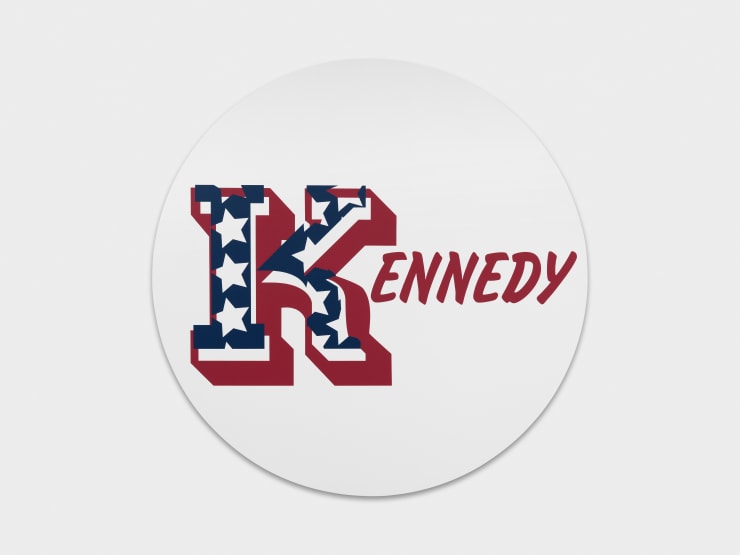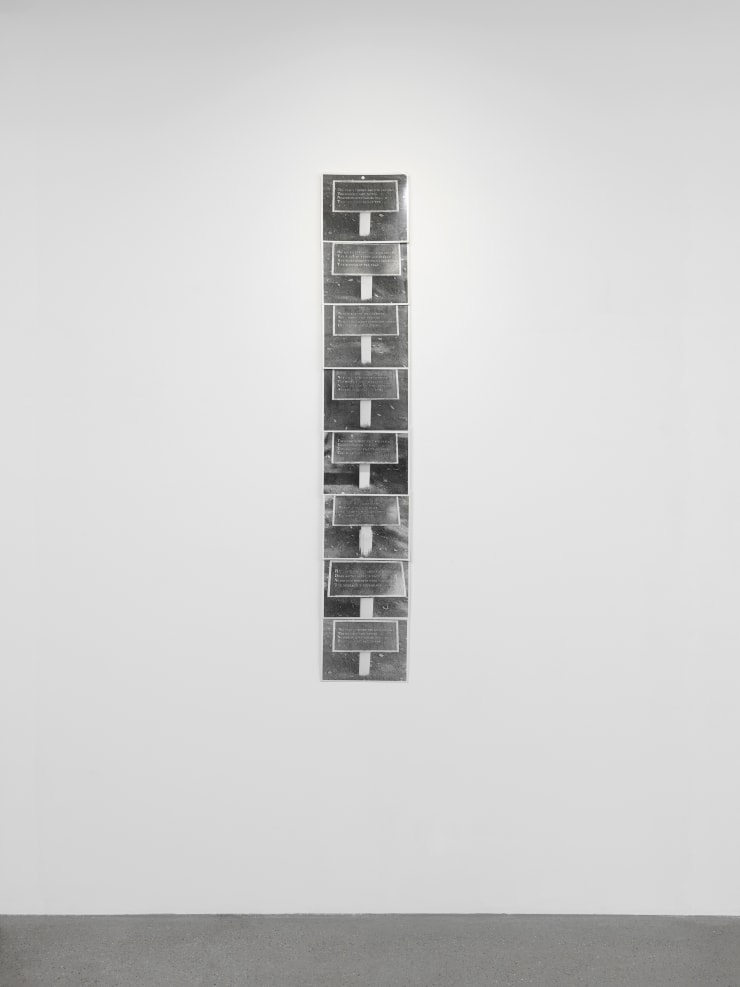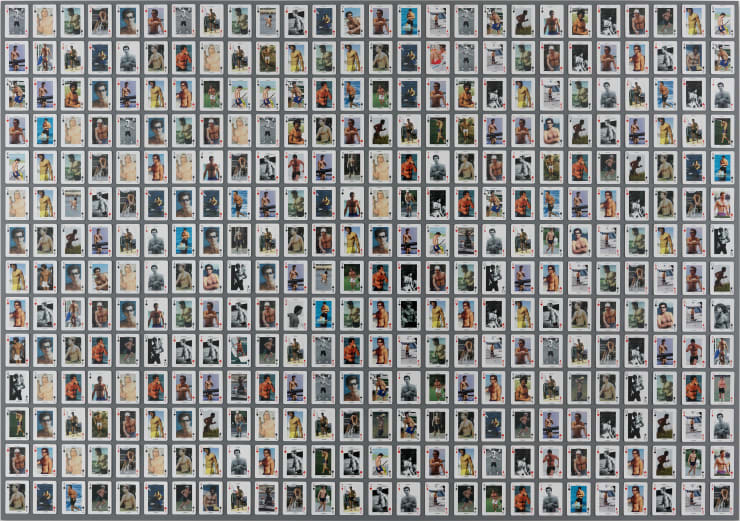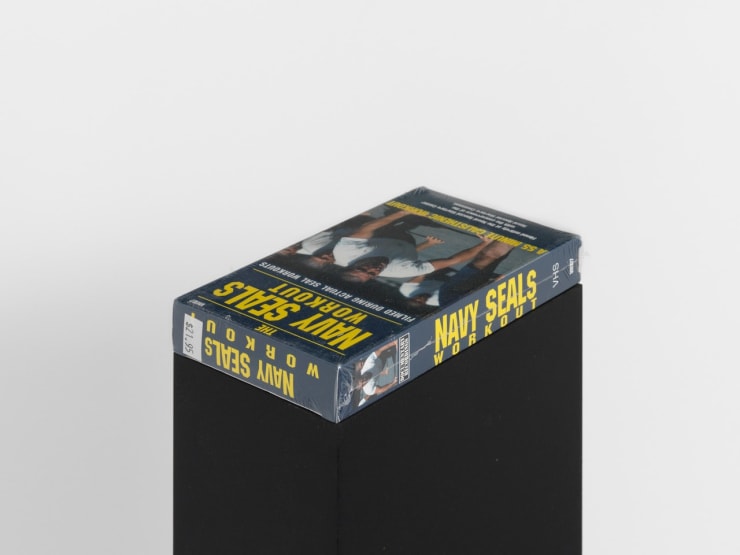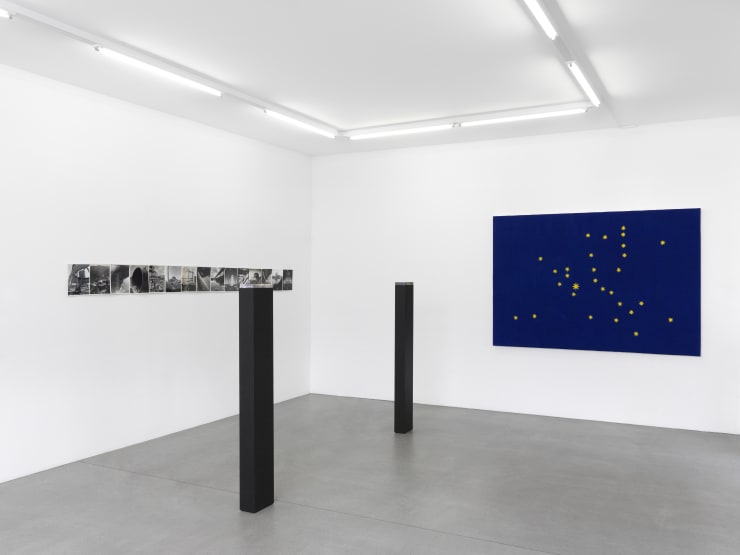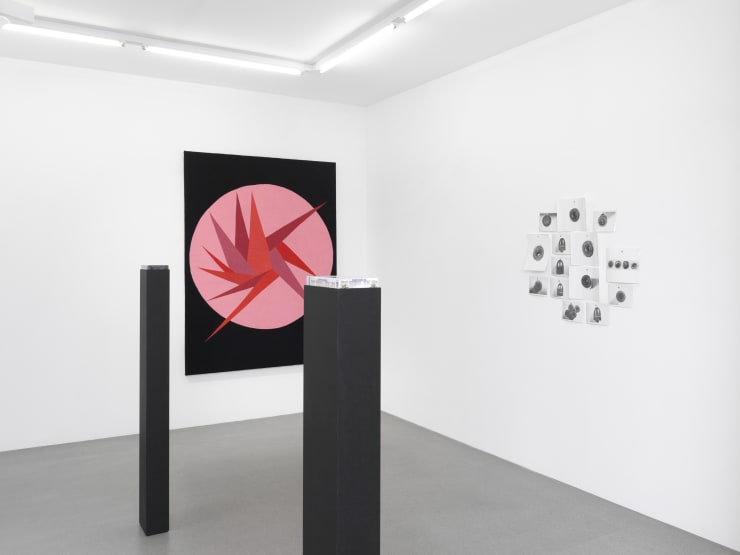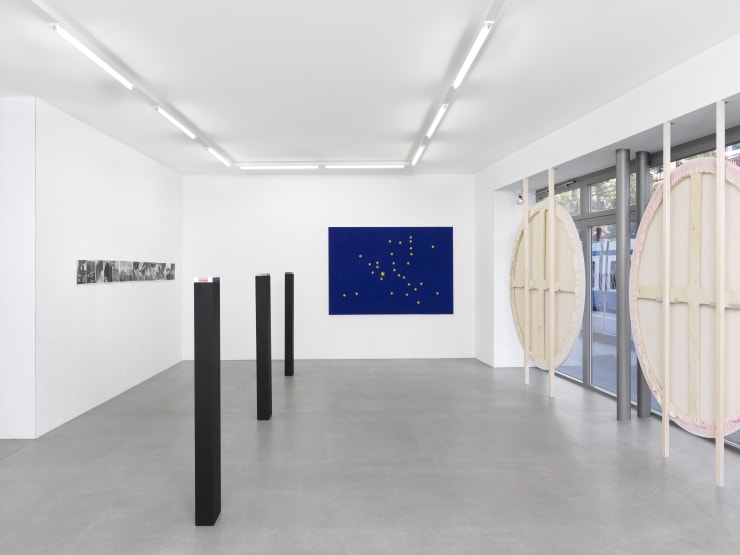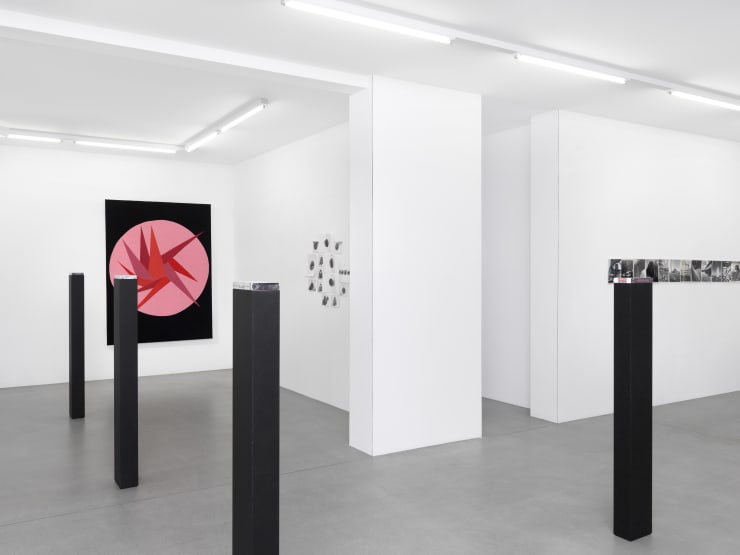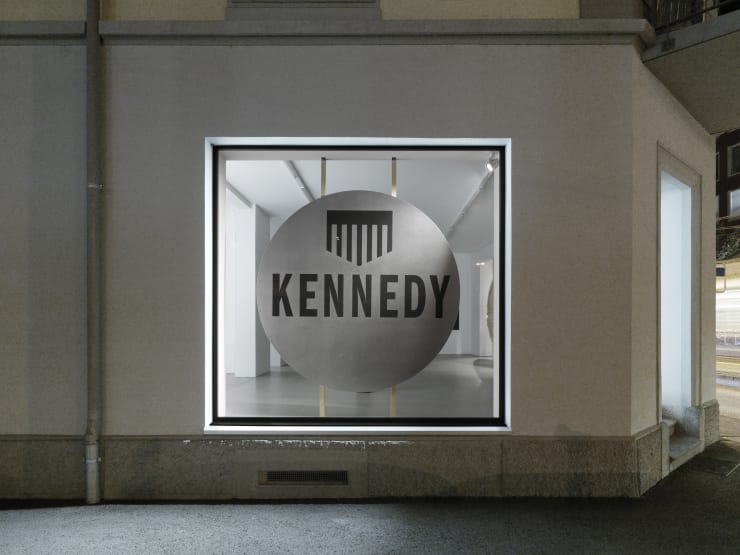Recurrence : Mitchell Anderson
Galerie Maria Bernheim announces Recurrence, Mitchell Anderson’s first solo exhibition at the gallery. The show is comprised of new series of sculptural and wall hanging works, in a variety of mediums, tied together by Anderson’s mediation and archiving of objects and images that carry the narratives of unfulfilled histories. The show will explore motifs of possibility, loss and obsolescence across historical, artistic and personal boundaries.
The gallerie’s large storefront windows will be blocked by three new works from Anderson’s ongoing series, Fortunate Son, large hard edge graphic paintings rendering political campaign buttons from the continuing eight decade reign of the American political dynasty, the Kennedy family. Referencing iconic social commentary in pop art, like that of Robert Indiana, the paintings always only depict the word Kennedy with only changes in font, style and design. In doing so they comment upon the hope and utopian values inherent in the public presented these political marketing tools and the lack of change and privilege within a perceived democracy. The works placement, facing out towards the street will turn the gallery into a kind of hyper campaign office, creating a visual protection or prevention for the works inside.
A new series of large hand embroidered tapestries continues Anderson’s interest in the contained information in images and the embedding of considered meaning in textile work. A large pink circle against a black background is covered with jutting angles of different tones. A streamlined rendered version based of Varvara Stepanova’s iconic sketch ‘Study the Old, but Create the New’ (1919), Anderson takes the unfulfilled possibilities of the Russian Avant-garde and the Russian revolution and abstracts them into a shape of continued desire. Similarly, a large field of blue scattered with eight pointed stars is taken from the runner-up proposal for the flag for the Council of Europe, what would later become the flag for the European Union. A never created prospect showing the possibilities of unity without borders, here the work becomes a reminder and aspiration for a time when European unity was seen as a necessity. Executed by hand over hundreds of hours, in a parallel to the geo-political works of Alghiero e Boetti, the pieces are embedded with community and time as agents of possibility and remembrance.
Similarly a new group of works dealing with seemingly obsolete images continue Anderson’s interest in the archive as a sight of clarity. Consisting of original silver gelatin prints from the archive of the American Heritage Company, a stock photography company for educational textbooks, the works exhibited collect disparate segments of the archive, pinned to the wall so that they float in space. For recurrence, the archive images focus around the Tennessee Valley Authority, a depression era federal office continuing today which oversees the construction of public works to fight poverty in the rural south. Other archives range from dancing to crime. All the images, rendered redundant with the onset of digital image
storage, and the slow edit of passing time, collect lost information, images of social cohesion and anticipation.
The exhibition space will be scattered with stele like sculptures, thin tall black pedestals, inset at the bottom, in the manner of the sculptures of Anne Truitt. Placed atop each are sealed VHS tapes, virgin deadstock that Anderson now harnesses for their object and visual meaning, rather than the media images that are contained within. Wanderings into specifics of social and political moments, to more obscure oddities, the sculptures once again act as memorials.
Taken together the exhibition shows Anderson’s singular way of dealing with the legacy of the readymade object and the appropriated image. As an American, having lived his entire adult life in Europe, his interest in the narrative possibilities that exist in the physical world is abutted with a firmly socially conscious awareness. Each of the works holds its own story, but is abstracted so it becomes an object of contemplation.
Mitchell Anderson was born in Chicago in 1985 and lives in Zurich. Recent solo and group exhibitions include Fri-Art Kunsthalle Fribourg, MAMCO, Geneva and will be included in the Swiss Art Awards 2018.
Venue: Galerie Maria Bernheim, 257 Limmatstrasse, Zurich
-
 Mitchell AndersonFortunate Son, 2018Acrylic on canvas200 cm diameter
Mitchell AndersonFortunate Son, 2018Acrylic on canvas200 cm diameter
78 3/4 in diameter -
 Mitchell AndersonFortunate Son, 2018Acrylic on canvas200 cm diameter
Mitchell AndersonFortunate Son, 2018Acrylic on canvas200 cm diameter
78 3/4 in diameter -
 Mitchell AndersonFortunate Son, 2018Acrylic on canvas200 cm diameter
Mitchell AndersonFortunate Son, 2018Acrylic on canvas200 cm diameter
78 3/4 in diameter -
 Mitchell AndersonLegal Midnight Hour, 2016Vintage photographs, American Heritage Archive, magnets
Mitchell AndersonLegal Midnight Hour, 2016Vintage photographs, American Heritage Archive, magnets -
 Mitchell Andersona drawing down of blinds, 2016-17Vintage photographs, American Heritage Archive, magnets
Mitchell Andersona drawing down of blinds, 2016-17Vintage photographs, American Heritage Archive, magnets -
 Mitchell Andersonheroic spiritual grandfather , 2016-2018Vintage photographs, American Heritage Archive, magnets
Mitchell Andersonheroic spiritual grandfather , 2016-2018Vintage photographs, American Heritage Archive, magnets -
 Mitchell Andersonrecurrence (Study the old, but create the new), 2018Hand embroidered cotton200 x 140 cm
Mitchell Andersonrecurrence (Study the old, but create the new), 2018Hand embroidered cotton200 x 140 cm
78 3/4 x 55 1/8 in -
 Mitchell AndersonWe Two How Long We Were Fool’d, 2018Playing cards, dispersion on panel200 x 130 cm
Mitchell AndersonWe Two How Long We Were Fool’d, 2018Playing cards, dispersion on panel200 x 130 cm
78 3/4 x 51 1/8 in -
 Mitchell Andersonrecurrence (A Flag For Europe), 2018Hand embroidered cotton200 x 140 cm
Mitchell Andersonrecurrence (A Flag For Europe), 2018Hand embroidered cotton200 x 140 cm
78 3/4 x 55 1/8 in -
 Mitchell Andersonour distant rest (uncut), 2018Sealed VHS tape, oiled MDF141 x 20 x 11.5 cm
Mitchell Andersonour distant rest (uncut), 2018Sealed VHS tape, oiled MDF141 x 20 x 11.5 cm
55 1/2 x 7 7/8 x 4 1/2 in -
 Mitchell Andersonthe haunting flares (uncut), 2018Sealed VHS tape, oiled MDF141 x 20 x 11.5 cm
Mitchell Andersonthe haunting flares (uncut), 2018Sealed VHS tape, oiled MDF141 x 20 x 11.5 cm
55 1/2 x 7 7/8 x 4 1/2 in -
 Mitchell Andersonour distant rest (cut), 2018Sealed VHS tape, oiled MDF141 x 20 x 11.5 cm
Mitchell Andersonour distant rest (cut), 2018Sealed VHS tape, oiled MDF141 x 20 x 11.5 cm
55 1/2 x 7 7/8 x 4 1/2 in -
 Mitchell Andersonthe haunting flares (cut), 2018Sealed VHS tape, oiled MDF141 x 20 x 11.5 cm
Mitchell Andersonthe haunting flares (cut), 2018Sealed VHS tape, oiled MDF141 x 20 x 11.5 cm
55 1/2 x 7 7/8 x 4 1/2 in -
 Mitchell Andersonsome smothering dreams (uncut), 2018Sealed VHS tape, oiled MDF141 x 20 x 11.5 cm
Mitchell Andersonsome smothering dreams (uncut), 2018Sealed VHS tape, oiled MDF141 x 20 x 11.5 cm
55 1/2 x 7 7/8 x 4 1/2 in -
 Mitchell Andersonsome smothering dreams (cut), 2018Sealed VHS tape, oiled MDF141 x 20 x 11.5 cm
Mitchell Andersonsome smothering dreams (cut), 2018Sealed VHS tape, oiled MDF141 x 20 x 11.5 cm
55 1/2 x 7 7/8 x 4 1/2 in



